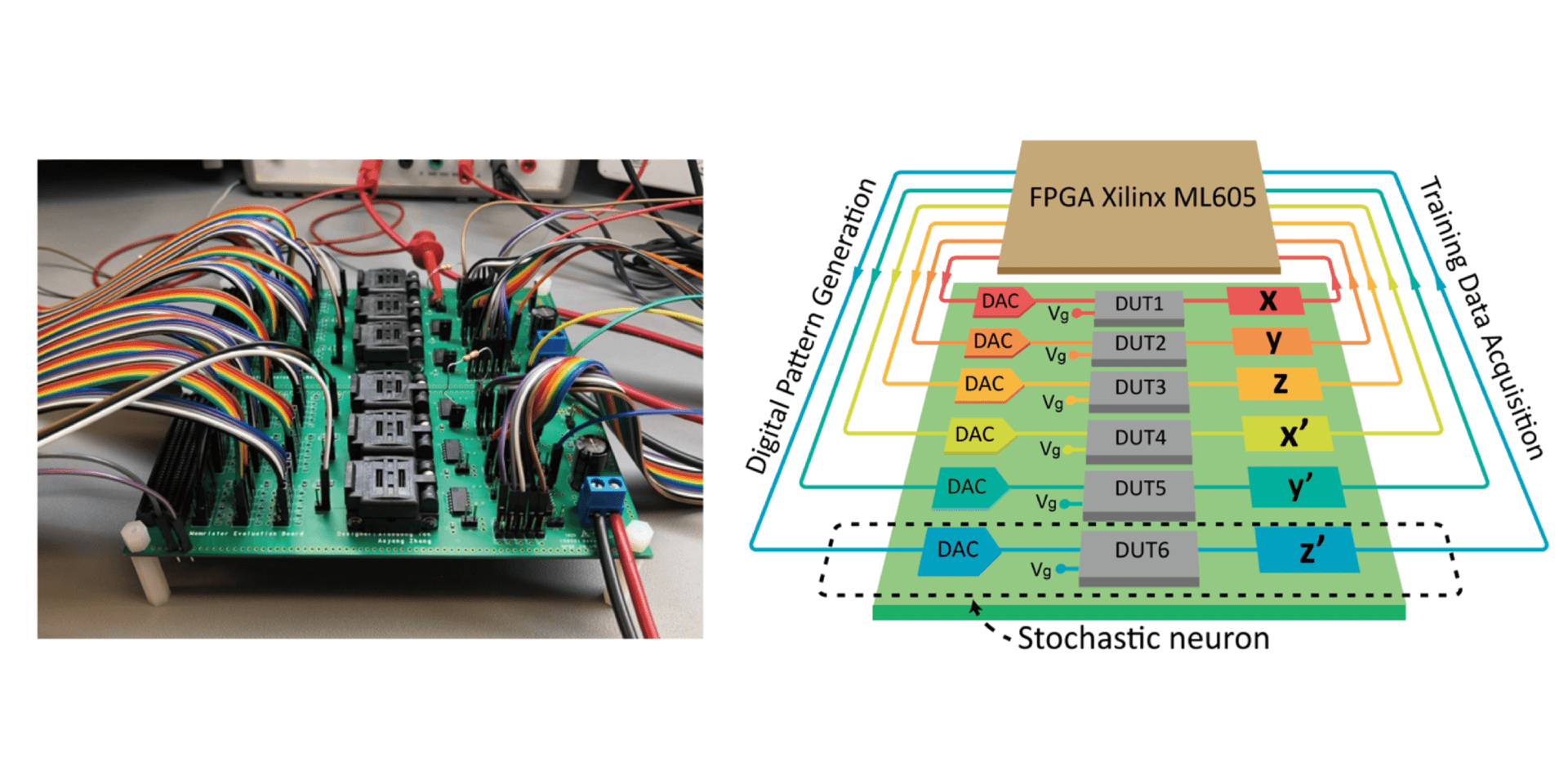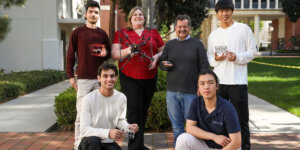 While AI is often perceived by the public to be affiliated with software, researchers in Han Wang’s Emerging Nanoscale Materials and Device Lab at USC Ming Hsieh Department of Electrical and Computer Engineering and the Mork Family Department of Chemical, focus on improving AI and machine learning performance through hardware. The lab, whose work is concentrated on neuromorphic computing or brain-inspired computing, has new research that introduces hardware improvements by harnessing a quality known as “randomness” or “stochasticity”. Their research now published in Nature Communications, contradicts the perception of randomness as a quality that will negatively impact computation results and demonstrates the utilization of finely controlled stochastic features in semiconductor devices to improve performing optimization.
While AI is often perceived by the public to be affiliated with software, researchers in Han Wang’s Emerging Nanoscale Materials and Device Lab at USC Ming Hsieh Department of Electrical and Computer Engineering and the Mork Family Department of Chemical, focus on improving AI and machine learning performance through hardware. The lab, whose work is concentrated on neuromorphic computing or brain-inspired computing, has new research that introduces hardware improvements by harnessing a quality known as “randomness” or “stochasticity”. Their research now published in Nature Communications, contradicts the perception of randomness as a quality that will negatively impact computation results and demonstrates the utilization of finely controlled stochastic features in semiconductor devices to improve performing optimization.
In the brain, randomness plays an important role in human thought or computation. It is born from billions of neurons that spike in response to input stimuli and generate a lot of signals that may or may not be relevant. The decision-making process perhaps is the best-studied example of how our brain makes use of randomness. It allows the brain to take a detour from past experiences and explore a new solution when making a decision, especially to a challenging and unpredictable situation.
“Neurons exhibit stochastic behavior, which can help certain computational functions” said a USC PhD student Jiahui Ma and a lead author Xiaodong Yan (both equally contributed as first authors). The team wanted to emulate neurons as much as possible and designed a circuit to solve combinatorial optimization problems, which are one of the most important tasks for computers to complete.
The thinking is that for computers to do this efficiently, they need to behave more like the human brain (on super steroids) in terms of how they process stimuli and information, as well as make decisions.
In much simpler terms, we need computers to converge on the best solution among all possibilities. Says the researchers, “The randomness introduced in the new device demonstrated in this work can prevent it from getting stuck at a not-so-viable solution, and instead continue to search until it finds a close-to-optimal result.” This is particularly important for optimization problems, says corresponding author Professor Wang, “If one can dynamically tune the randomness features, the machine for performing optimization can work more efficiently as we desire.”
The researchers achieve this dynamic “tuning” by creating a specialized device, a hetero-memristor. Unlike transistors which are logic switches inside a regular computer chip, the hetero-memristor combines memory and computation together. Memristors have been developed prior, normally with two-terminal structure. The Viterbi team’s innovation is in adding a third electrical terminal and modulating its voltage to activate the neuron-like device and to dynamically tune the stochastic features in its output, much like one heats up a pot of water and dynamically adjusts the temperature to control the activity of the water molecules, hence enabling the so-called simulated “cooling”. This provides a level of control that earlier memristors do not have.
The researchers say, “This method emulates the stochastic properties of neuron activity.” In fact, neuron activity is perceived to be random, but may follow a certain probability pattern. The hetero-memristors they developed introduce such probability-governed randomness into a neuromorphic computing circuit by the reconfigurable tuning of the device’s intrinsic stochastic property.
This is thus a more sophisticated building block for creating computers that can tackle sophisticated optimization problems, which can potentially be more efficient. What’s more they can consume less power.
The full research team includes Xiaodong Yan, Jiahui, Ma Tong Wu, Aoyang Zhang,
Jiangbin Wu, Matthew Chin, Zhihan Zhang, Madan Dubey, Wei Wu, Mike Shuo-Wei Chen, Jing Guo, & Han Wang.
Research was done in collaboration with the Army Research Laboratory, the University of Florida and Georgia Tech.
Published on November 21st, 2021
Last updated on May 16th, 2024













